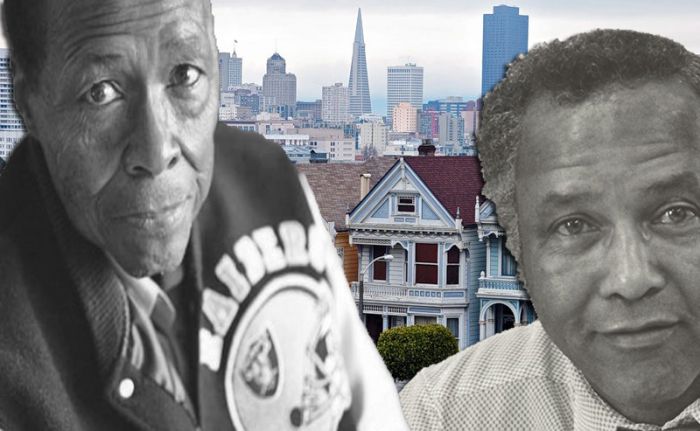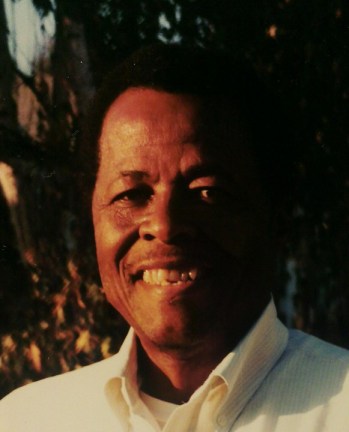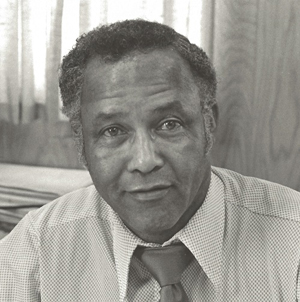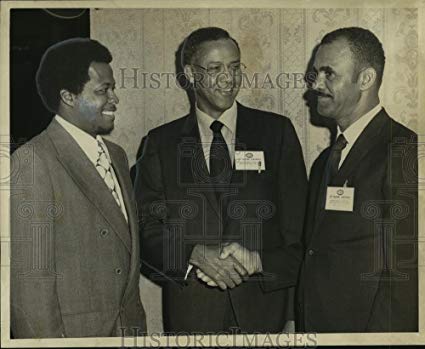Joe and Ray paved the way for black contractors across America

The activism of African American construction contractors in
an important, and often overlooked, piece of the broader history of racial
exclusion in the national construction industry. Black contractors seldom receive consideration
as agents of historic change. The study of black/African-American contractors
provides a distinct grassroots perspective from which to view the relationship
between black business and black labor.
African-American contractors’ historic link to black workers
was a central component in the late 1960’s and 1970’s. By the time that civil
rights activists launched mass protest that shut down construction sites in the
1960’s, black tradesmen and contractors in the San Francisco Bay area had spent roughly two
decades trying to compel the lily-white building trades unions to open their
doors to black workers.
Although the history of racial discrimination and exclusion
in organized labor unions dates back to the nineteenth century, after slavery, in places such as the Bay Area the issue became particularly
apparent in the 1940’s after World War II, with the massive wartime migration
of black Americans from the South & Midwest.
Many of the tens of
thousands of black Americans who migrated to the Bay Area in the decades after
WWII were experienced and skilled tradesmen, such as plumbers, pipe fitters,
electricians, painters, and plasterers who sought work in the booming shipyards
and expanding commercial and residential construction markets. But like other
black tradesmen that arrived in other union strongholds such as New York,
Chicago, Pittsburg, and Seattle during and after WWII, these tradesmen found
themselves subjugated to severe racial discrimination, and restrictive labor
unions.
When confronted with union discrimination, black tradesmen
responded in a variety of ways: some looked for work in other industries, or
accepted lower-paying and less-skilled construction work as laborers; others
sought assistance from civil rights organization, and government agencies, but
these entities did not produce substantial and permanent gains for black
tradesmen. However, skilled black tradesmen could also exercise another option –
contracting.
The decision to become contractors grew out of constant
severe discrimination, and economic necessity. By setting up shop for themselves,
black tradesmen who took the state contractors’ licensing exam improved their
chances of avoiding union discrimination and gaining a greater degree of
control over their work lives.
As black contractors bettered their chances to earn a living
in the construction industry, they also created important roles for themselves
as employers and mentors for black tradesmen who were curtailed by labor unions
in their search for work and training opportunities. Through their close
relationships with black tradesmen, black contractors established an important
link to the growing Bay Area black communities.
As small, new contractors, starting out for the first time post World War II in the vast construction industry, black contractors were mostly sole
proprietorship's , and the owner was usually his own best worker. The majority
of black contractors in this period built one or two houses a year and spent
most of their time performing repairs and ‘patch work.’
In fact, according to a 1968 estimate of the Small Business
Administration (SBA), only 8,000 of America’s approximately 870,000
construction firms were black or minority-owned. The disparity between black
and white contractors widened throughout the 1960’s as, in the Bay Area and
across the United States, residential construction begin to stagnant, while
large-scale, especially government-financed construction expanded.
Moreover, in 1969 the presidential Cabinet on Construction
predicted that the “United States will put in place in the next 30 years as much construction as there has been from the founding of the Republic to now.” Yet black contractors stood to gain little
from the construction boom.
According to a 1967 report, for instance, black/minority
contractors accounted for less than $500 million of the $80 billion U.S.
construction industry. This disparity was evident in the Bay Area, where by
1968 not one of the approximately 125 black contractors in the region was working
on a large publicly financed job.
Joseph Dedro
enters the industry
In cities across the United States, a small number of black
contractors and business leaders sought to make changes for the better of blacks in the
construction industry. Chief among them was Joseph Debro. Born in Jackson,
Mississippi, Debro came to the Bay Area with his parents after WWII, and became
a contractor.

Debro entered into construction with advanced university training,
after obtaining an undergraduate degree in engineering and a master’s degree in
biochemistry from the University of California. Debro became interested in
large-scale construction projects while working as an engineer on the
construction of Interstate 580 in the East Bay during the 1950’s. In the years
following, he developed a keen interest in the problems confronting black
contractors and emerged as one of the leading advocates for black contractors.
Beginning in the 1960s, Debro focused his work on overcoming
the four major obstacles that prevented black contractors from expanding their
companies and obtaining lucrative government contracts: Lack of Skilled Labor,
Lack of Technical Management Skills, Lack of Capital, and Bonding Requirements.
The lack of skilled workers for instance, was a direct result of the building
trades unions, which controlled the primary avenue to apprenticeship training.
But, the fourth obstacle – bonding requirements – proved the most troublesome
for black contractors to overcome.
Because of their historical lack of capital and technical
training, black contractors claimed that the bonding requirements created a
vicious cycle in which most black contractors lacked experience, capital, and
managerial capabilities required to obtain the bonds they needed to quality for
various types of projects that would give them the experience needed to qualify.
But, Surety companies that issued bonds, claimed that they also
considered other factors when deciding whether to issue a bond or not, such as
the “three C’s”: Character, Capital, and Capacity. Although,in a unpublished 1968
memorandum, the American Insurance Association stated that it believed “that it
will serve NO USEFUL PURPOSE, economic or sociological, for surety companies to
issue contract bonds indiscriminately to all applicants, qualified or not.”
Black contractors considered such practices as examples of
racial discrimination and frequently protested that the industry perpetuated a
double standard. As a result, Debro and other black contractors testified to congress that
surety companies denied bonds to qualified black contactors, but these charges
of overt discrimination were often difficult to prove because the majority of
black contractors could not meet the capital requirements of most bonding
companies anyways.
Debro believed something needed to change, and that the free
market could not solve the bonding problems, nor the other obstacles that
limited black contractor’s opportunities. He felt that “all these problems are
aggravated by the inaction of city leaders (working) in the unions, government, private
business, and universities who should be devoting their time to mobilizing
resources on a local level to cope with the exclusion of minorities from all
phases of the construction industry.”
However, before black contractors could expect to receive external
assistance, Debro felt that they needed to organize themselves on a larger
scale.
Joe meets Ray
In the Bay Area, protesters begin to target the construction
of the Bay Area Rapid Transit System (BART), a billion-dollar project that was
scheduled to take five years to complete. Much of BART’s construction was
located in some of the poorest neighborhoods in Oakland and San Francisco, and
local residents made it clear that they would not stand by idly while white
construction crews performed work and earned middle-class wages.
And it was in that tumultuous atmosphere that a black
electrical contractor named Raymon Dones walked into Joseph Debro’s office in
1966. Although Ray was not seeking a contract on the BART project, he hoped
that Joe Debro, who was at the time, serving as the executive director of the Oakland Small
Business Development Center (OSBDC), could help him obtain a loan so that he
could bid on other government projects.

Born in Marshall, Texas, Raymon Dones moved to the Bay Area in
1950, and in 1953 he established Dones Electric (which later became Aladdin
Electric) in Berkley, CA. Like many
other black contractors in the Bay Area during this period, Aladdin Electric
procured steady employment on small residential buildings, and by the mid-1960’s
he had a workforce of six full-time electricians – all of whom were black.
Yet when the residential construction market slowed down, Ray was unable to obtain surety bonds to bid on lucrative government –financed
construction projects, and as a result he had to lay off two of his
electricians. Hoping to avoid further cutbacks and looking to expand his
company, he visited Joe Debro at the OSBDC.

Ray Dones and Joe Debro immediately hit it off , and instead of
arranging a loan they discussed forming an organization that could assist black
contractors in making the transition from small residential construction to
larger public-sector projects. Shortly thereafter,
Dones and Debro formed the General and Specialty Contractors Association
(GSCA), which was among the first black contractor associations in the United
States.
The founders of the GSCA hoped their organization would appeal to small-scale contractors by offering a variety of programs designed to provide the managerial and technical assistance needed to compete with more established firms on large and publicly financed projects.
In its first three
years, the GSCA developed programs to provide information to black contractors
about publicly funded contracts, and assisted inexperienced members with
preparing estimates, and business procedures on jobs in progress, as well as mediated in labor disputes.
And in 1968, six GSCA members pooled their resources to form
Trans-Bay Engineering and Builders, Inc., a general contracting firm that they
hoped could compete with the larger white-owned contracting companies in the
Bay Area.
Creating
opportunities & training the Bay
The GSCA also placed emphasis on training black workers for
the building trades. Because of their need for skilled tradesmen, the GSCA
contractors made training black and other races of workers an important part of
their mission. GSCA contractors stressed
that the historical link between black contractors and the unions’ history of
discrimination caused young blacks to avoid union-administered apprenticeship
programs. GSCA leaders insisted, most construction workers learned trade skills
through on-the-job training - something black workers acquired while working
for black contractors.
Black contractors sought a model for integrating
construction training into the black community, which would at the same time eliminate
the barriers that limited their access to jobs. By the summer of 1967, the GSCA
and the OSBDC had drafted a ‘community action program’ for Oakland that
proposed the of use black contractors as the primary vehicle for training black
workers.
The plan called for
an “On-the-job Training Credit Bank” that would provide training and employment
for approximately six-hundred workers while creating an economically viable
group of building contractors who would be able to carry-on the training of black
workers, and assist contractors with increaing their business skills.
After the program was rejected financing by the federal
government. Dones and Debro eventually found proper funding, from private
philanthropies, such as the Ford Foundation, which provided a 3-year, $300,000 grant
in 1968, so that the Credit Bank could help cover the costs of training black
construction workers, while simultaneously increasing the bond capacity of black
contractors.
The Oakland Bonding Assistance Program, as it was named, produced immediate results. Within a few months of operation, the program made 35 bond-related advances totaling $287,544, to black contractors to secure bonds needed to bid on government projects.
Trans-Bay Engineers and Builders was the
program’s biggest client. It was able to obtain an interest-free $50,000 loan
from the fund to secure a bond on the construction of the West Oakland Health
Center, a contract that the company would have otherwise lost because the surety
company had cancelled company's bond at the eleventh hour.
The GSCA also formed a program called PREP (Property
Rehabilitation Employment Project), and formed a cooperation with the Alameda County
Building and Construction Trade Council, which was eventually financed with grants
for the Department of Labor and the Ford Foundation. One of PREP's mission was to help black
tradesmen with previous construction experience attain journeyman status. And,
in 1969 PREP provided construction training to hundreds of black youth who were unable to
get into union apprenticeship programs.
The success of the these programs helped GSCA become an integral component of the Oakland
Redevelopment Agency’s (ORA) attempts to maximize black participation in its
West Oakland projects. GSCA helped black and other races of contractors secure “turnkey”
agreements with the Oakland Housing Authority.
This level of participation had a direct impact on black
employment on redevelopment projects. And in 1970, Joe Debro reported that 200 new
jobs had been generated and black tradesmen work hours and wages roughly doubled,
and “generated more non-white union journeymen in the in the high-wage crafts
than in the entire history of the local hiring-hall process.”
The GSCA’s pilot project in the Bay Area became a model for
programs across the Unuted States, and helped Bay Area contractors take a lead role in the
founding a national black contractors association to build upon their success.
Based on early returns, and success in Oakland, the Ford Foundation helped
launch similar programs in New York, Boston, and Cleveland.
By organizing themselves into collective associations and
advancing their program in Oakland, Joe Dedro and Ray Dones’ programs and
policies had gone on to effect the national agendas, and have in recent years inspired black
contractors and other minority contractors to create organizations that
successfully address discrimination in the historically racist construction
industry.
JOE AND RAY'S LASTING LEGACIES...

After retirement, Joe Debro never ceased to be active in his community and began writing for several community newspapers, including the San Francisco Bay View, a national Black newspaper; the East Bay Express; and the Oakland Post.
He continued to mentor and advocate for young business people and contractors, trying to break down the barriers of racial exclusion in trade unions and government contracting.
Joe Debro struggled to insure that all of his children
acquired an education, and all three of his sons not only graduated college,
but attained Master’s degrees. The middle son, Karl, earned his doctorate a
year before his father’s death.

AAs for Ray Dones, during his 20 years of business, Ray was ranked in the Top-6 black construction contractors in the United States, completing over $200 million worth of construction contracts. He made history in 1970 when he partnered the company he helped create, Tran-Bay, with Turner Construction to create the first joint venture project between a major firm and a minority builder.
In 1999, Engineering New-Record magazine named Raymon Dones as one of the most influential people in the construction industry
over a 125-years period.
Ray continued his activism in the community throughout his lifetime. He served on the National Urban League, UC Regents of Advisors, the Oakland Chamber of Commerce, and as a volunteer with the Museum of African-American Technology (MAAT)
BOTH MEN WILL TRULY BE MISSED BUT THEIR LEGACIES AND CONTRIBUTIONS TO THE BETTERMENT OF BLACK CONTRACTORS & BLACK TRADESMEN WILL LIVE ON AND NEVER BE FORGOTTEN!
